


|
Nine new adventures of Ellery Queen! A complete novel and eight more short stories! The Lamp of God, the novel, is one of the weirdest stories about a disappearing house that only can be matched by Poe. ... A most ingenious tale about a curious treasure hunt, hidden gold, a house of horror, and murder. The solution depends on the whim of a dead man in building two identical houses, and fate in producing two almost identical people. Four sports mysteries featuring baseball, horse racing, pugilism and football full of the sporting world vernacular, will delight the fans. The New Adventures of The Treasure Hunt, The Hollow Dragon, The House of Darkness and The Bleeding Portrait complete the list of stories. Ellery Queen at his best.... New adventures.... humor.... horror.... romance.... and the supreme in deduction and observation! Try and match Ellery Queen with your wits. Enjoy his versatility in this marvelous variety of stories. |
|
| Titles starting with ... begin with "The Adventure of...." Short stories originally appeared in other magazines as indicated above. "The Adventure of the Treasure Hunt" was reprinted in the first issue of Ellery Queen's Mystery Magazine. The Blue Book stories represent the "sports detective series". |
|
"Includes a short novel "The Lamp of God" which is one of the best
stories so far by this top notch thriller."
--
The California Eagle " 'The Lamp of God' which is a short novel that I am sure will be snapped up for the movies. It's just the thing to follow up "The Ghost Breakers" with and provide excellent roles for Paulette Goddard and Bob Hope. Ellery Queen can certainly write and pile up suspense. I wouldn't want to miss one of his brainchildren." -- Dorothy Quick, The East Hampton Star "Mr. Queen never shirks his task; he concocts and elaborates his plots with apparent enjoyment; this book is a repository of value to devotees of the bizarre." -- The New York Sun |
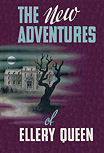     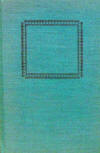 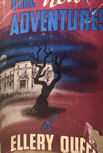   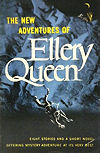 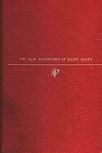 |
|
Above left to right: Both
dust cover and hardcover for Stokes, Grosset & Dunlap editions;
dust & hardcover Blakiston/Triangle edition (1941). Below left to right: dust & 2 hardcover variations for Blakiston/Triangle edition (1944); dust & hardcover Tower edition. (Click on the covers to see the differences) * |
|
Brooklyn Eagle, January 23. 1940 "But Houses Don't Walk. All of nine stories have been thrust into "The New Adventures of Ellery Queen" (Stokes, $2.00), by Ellery Queen. They are a brief novel and eight short stories—four of the latter sports mysteries. And, together, they are tinged by the brisk, baffling Ellery Queen touch, though occasionally they are overdone. The novelette, "The Lamp of God", furnishes the most stirring scenes. In this Queen is called upon to understand why a house has disappeared in the night, and to know how to return the devilish domicile to its foundations. Queen is also consumed with concealed gold, a murder and a mental breakdown. The other yarns bring out a treasure hunt, a hollow dragon, a house of blackness, and a bleeding bit of portraiture. There is as much gayety as grim apprehensiveness." |
| The Lamp of God was what Ellery Queen named the light that gave him the clue which helped solve one of the most eerie cases in his career -- the case of the disappearing house containing a fortune in gold, and a murder plot that was almost beyond belief. "The Lamp of God" (1935) deals with an impossible crime story; an entire house vanishes, a typical EQ trick, given his use of very eccentric Howard Hughes types somewhere along the line -- this is much more fun in short-story format than at novel length. It does have features of real imagination, especially dealing with the impossibility. The first half of Lamp is a full Gothic tale. There is a full atmosphere of horror, climaxing on Ellery's speculations of a science fictional explanation for the crime. The tale has affinities with The Tragedy of X (1932). Both deal with a long complex history, in which villains engage in elaborate plots. Neither is especially plausible. Both have a somewhat sinister atmosphere. In different ways, it is similar to "The Bearded Lady" (1934), in which complex family relations converge on sinister events at an isolated house. (Michael E.Grost) |
 Above: "The Lamp of God" in the Dutch newspaper De Waarheid (feb 1947) as "Het Verdwenen Huis" ("The Missing House") The newspaper published three other short stories that same year: "Het gestolen paarlencollier" ("Treasure Hunt"), "Het raadsel van de Japanse Draak" ("The Hollow Dragon") and "Mimi Gramatons geheim" ("The Bleeding Portrait") |
| "The House of Darkness" (1935) and "The Treasure Hunt" (1935) show EQ's skill with elaborate, surrealistic backgrounds for his fiction. Both stories are also good mystery puzzles, not too realistic, but imaginative in their plotting. The estate of the retired General in "The Treasure Hunt" recalls that of retired actor Drury Lane in The Tragedy of X (1932). |
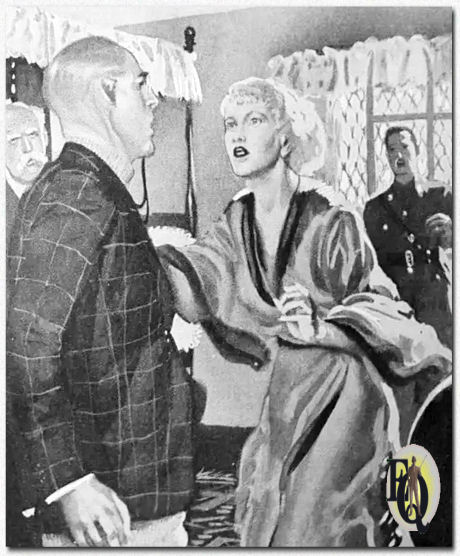 Above: "Someone's stolen my necklace," she said fiercely. "Mr. Queen, you must get it back. You must, do you hear?" The Strand Magazine (9/1934) featured Ellery Queen's "Treasure Hunt", illustrated by R.M Chandler. |
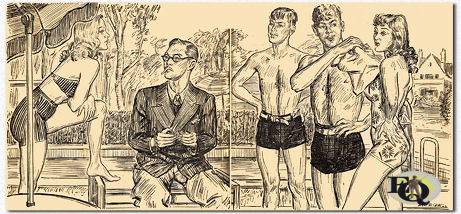 Above: The Oct 6. 1943 edition from the popular Argentinian magazine Leoplan featured "La Casa Del Tesoro", the translation for Ellery Queen's short story "The Treasure Hunt". Stretched over two pages it had this artwork by Cristobal Arteche |
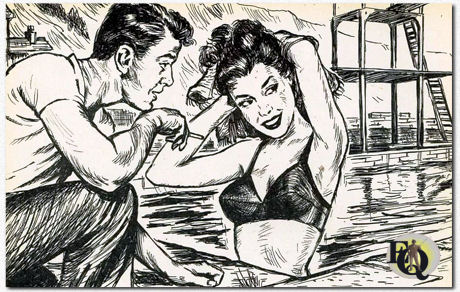 Above: When "The Adventure of the Treasure Hunt" was published in the September 1952 issue of Clubman magazine it had this artwork. "It looked like an innocent party game -but it was contrived to lead Ellery Queen to the guilty person." |
|
The cubist inspired designer of the "The House of Darkness" is a Frenchman, and recalls the similar French designer of the Art Deco furniture in The French Powder Mystery (1930). Another noteworthy feature of the early EQ stories is the presence of black people among the suspects. EQ is clearly trying to treat them in non-stereotyped ways. They are most fully present in "The House of Darkness". "The Bleeding Portrait" (1937), has some good atmosphere in its first half, but which never builds up much of a mystery plot. After writing 14 short stories, including a novella, in the three years 1933-1935, EQ
largely gave up the form in the next three, publishing only two mediocre shorts in
1936-1938. In 1939 EQ returned to the short tale with a series of four stories, all with
sports backgrounds. Each co stars Paula Paris, with whom EQ fell in love in
The Four of Hearts (1938). She is a
good character, but unfortunately she seems never to have returned after these works. The
first three stories are well done, and even the weaker final tale ("The Trojan
Horse") is a game attempt with some pleasant mystery; like "The
Treasure Hunt" it involves a long search for some stolen jewels. "Man
Bites Dog" has some affinities with the minimalist tales of poisoning EQ was
essaying in these years, such as The Four
of Hearts and Calamity Town
(1942).
"Long Shot" returns to the turf of
The American Gun Mystery
(1933), with a tale combining
Western characters, horses, and guns, the same elements of the earlier book. (Michael E.Grost) |
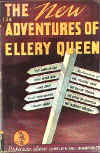  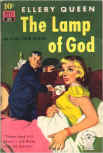 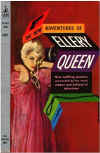   |
|
In How to Read a Short Story by Marjorie L. Burns the plot is discussed as having four elements. First the author reveals the situation that the characters find themselves in. The problem or conflict is exposed either by narrative or immediate action. Second, events and actions grow out of the conflict if it was fully revealed at the outset of the story. If the conflict is not immediately revealed because the author starts with action rather than narrative, then the readers must discover the conflict by carefully reading and observing what the characters do and say. This part of the plot is called rising action. Readers identify opposing forces in the story, perhaps two characters, a character and a force of nature (a storm), or a character and the problem he faces. Third is the turning point or climax in which the action reaches its acme and one opposing force wins and the other loses. In mystery or detective fiction the crime is solved. Fourth, the author shows the results of whatever was decided or revealed at the climax. The resolution in mysteries can be the explanation of the crime as only the detective or private eye could have determined it. "Man Bites Dog" is a good example of a story which is heavily reliant on plot and can be classified as an American version of the formal detective novel. The setting is the seventh game of the world series between the New York Yankees and the New York Giants. The characters include EQ, his date, gossip columnist Paula Paris, Inspector Queen and Sergeant Velie in one box behind the Yankee dugout. Below them are two boxes occupied by one couple each Big Bill Tree, ex-pitcher and Lotus Verne, shapely movie star, in one. In the other box were Big Bill’s estranged wife Judy Starr, Broadway celebrity and her escort Jimmy Connor, song-and-dance man. The exposition is in the introduction of the characters and the tension between the two couples, who are being closely scrutinized by Ellery Queen. To define "rising action", one would examine all of the characters’ by-play. Pocket Books awarded Gertrudes (little metal kangaroos) to authors whose books had sold over a million copies! In January 1946 presentations were made at a party at the Rainbow Room NY to Ellery Queen "Messrs. Dannay and Lee" for The New Adventures of Ellery Queen. |
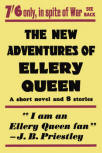 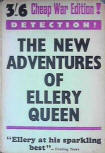 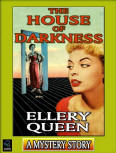 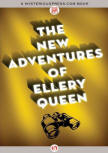 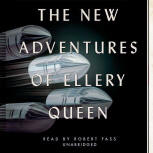 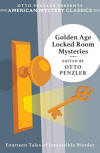 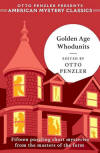 |
|
Above last row middle: Golden
Age Locked Room Mysteries, containing the short story "The House of
Haunts" van Ellery Queen - Otto Penzler Presents American
Mystery Classics, hardback & paperback cover, July 5. 2022. Above last row right: Golden Age Whodunits, containing "Man Bites Dog" by Ellery Queen - Otto Penzler Presents American Mystery Classics, hardback & paperback cover, June 2. 2024. |
|
Daily Telegraph, Sydney - April 20. 1940
"Mystery of the Week: The House that Disappeared" by Dr.
Watson Jun. "Here is Ellery Queen again — slick, entertaining, and dishonest as ever — bamboozled by the disappearance of a house. The house is a sinister mansion of grey stone, three-storied, 75 years old, crammed with furniture, and elaborately ornamented with gargoyles. It stands immediately opposite another old colonial home in an almost inaccessible wilderness of Long Island. There is no other habitation for miles. Ellery Queen arrives at the two houses in a snowstorm, accompanying a long-lost heiress, an evil fat octopus of a doctor and an earnest solicitor, to discover that the heiress' father has been murdered — presumably by the evil doctor, his half-brother. The dead man had lived for years in the grey old mansion, known as the Black House. The evil doctor, with a wife, an idiot half-sister and a huge male servant live opposite in the White House. Ellery Queen inspects the solid walls and furnishings of the deserted Black House and then goes dubiously to bed in the White House. When he awakes the next morning, the Black House has completely and utterly vanished. A wide sweep of snow-covered ground stretches nakedly where the Black House had stood for 75 years. There is not even the slightest trace of foundations. SOLUTION COLLAPSES Now, that, I submit, is an extra ordinarily interesting problem. It reminded me of Conan Doyle's "Lost Special" (the train that vanished), and Dorothy Sayers' "Haunted Policeman" (the London terrace-apartment that vanished). Unfortunately but inevitably, Ellery Queen's solution collapses with a dull sickening thud, infuriating and dismaying to the expectant student. Ellery Queen, after all, usually trips full-length over his solutions. He has a lush imagination, brisk style and daring originality, but mostly he escapes from his ingenious problems only by postulating fantastically absurd situations. His weakness is disguised more gracefully in the short stories that follow "The Lamp of God." There is a moving poison story, "Man Bites Dog," which demonstrates that even a hard-bitten Noo Yark flattie can be sentimental enough to hush up a crime if publicity may harm the grand old game of baseball. I liked, too, the murder in the Luna Park giggle-house ("The House of Darkness") , and the mystery of the historic portrait that dripped real blood whenever the mistress of the house was unfaithful to her husband ("The Bleeding Portrait"). I am also happy to record some interesting new biographical data about Ellery Queen. He doesn't like drinking going to bed, he hates curried food and he displays unsuspected religious fervor. I fear, moreover, that, as with Sexton Blake and Mlle. Yvonne and Perry Mason and Delia Street, the worst possible construction must now be placed on Ellery Queen's association with the attractive Paula Paris." |
|
The New Adventures
of Ellery Queen Translations: |
|
Other articles on this book (1) Reading Ellery Queen - The House of Darkness Jon Mathewson (2) Reading Ellery Queen - The Treasure Hunt Jon Mathewson (3) Reading Ellery Queen - The Lamp of God Jon Mathewson (4) Reading Ellery Queen - The Hollow Dragon Jon Mathewson (5) Reading Ellery Queen - The Bleeding Portrait Jon Mathewson (6) Reading Ellery Queen - Man Bites Dog Jon Mathewson (7) Reading Ellery Queen - The Long Shot Jon Mathewson (8) Reading Ellery Queen - Mind over Matter Jon Mathewson (9) Reading Ellery Queen - Trojan Horse Jon Mathewson (10) Reading Ellery Queen - The Teakwood Case Jon Mathewson (11) My Reader's Block Bev Hankins (April 15. 2011) |
|
*
Interested readers should know
that the icons/covers
of books, used throughout the
website have extra
descriptions/information not
included in the text on the same
page. Pointing your cursor at
the icon/cover used to reveal
this extra information. To achieve the same effect Firefox users can install an add-on called 'Popup ALT Attribute'. When installed pointing your cursor at an icon/cover results in showing you the details or additional information. |
|
Copyright © MCMXCIX-MMXXV Ellery Queen, a website on deduction. All rights reserved. |